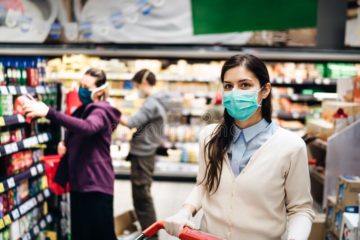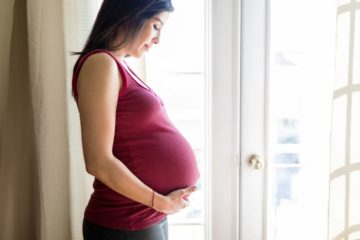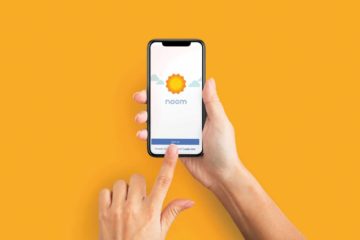by Carol A Westbrook

I pulled my mask up, making sure to cover my nose and mouth as we walked into the supermarket.
My husband looked at me quizzically.
“Why are you putting on your mask?”
I pulled off my mask and gave him a sheepish grin.
I forgot that the mask mandate had been lifted because the Covid-19 case rate is now so low that the chance of infection was almost negligible. But I know that this is temporary, as we will probably have another spike in the fall with the emergence of yet another Omicron variant. But for now we have a temporary reprieve, and we could get back to “normal.” But what is normal? Two years under the threat of Covid-19 has changed the way we do things. The post-pandemic normal will be different than it was before Covid, and here is how I think things will look.
We have changed the way we shop. For me, and for many other people, this is the first time I’ve actually shopped for groceries in person instead of ordering online. As I walked in, the store felt like a wonderland, so full of good things to buy that I couldn’t make up my mind. Yes, they even had toilet paper! Every brand and any size! (Remember the first few weeks of the lockdown, when one of our biggest fears was to be caught with our pants down, with nothing to wipe our rear ends?) Still, some products were in short supply, with their empty spots glaringly obvious, like a mouth with a missing tooth. Supply chain problems, they said.
Before Covid, I never thought I’d shop for groceries online; but after spending two years doing so, buying groceries by computer or cellphone feels like the norm. I can’t beat the time-saving convenience. Having someone else carry the load to my home spares my knees, which are starting to get ornery as I age. It will be hard to go back to shopping in stores. And much of the US feels the same way. The shift of retail buying from brick-and-mortar stores to digital stores had started before the pandemic, but because it happened so quickly many companies could not, or would not, accommodate. Economists claim that the shift to was accelerated by five years!
Retail shopping online is now firmly established in our culture, and we have gotten comfortable with it. Sadly, many of our favorite retailers were unable to adapt and went into pandemic bankruptcy. These include Lord & Taylor, Brooks Brothers, Chuck E. Cheese, Century 21 Stores, GNC, Guitar Center, J.C. Penney, J. Crew, Neiman Marcus, Pier 1, Men’s Wearhouse, Jos. A. Banks, Golds Gym, Hertz, and many others. The list reads like the directory of a typical shopping mall, and as a matter of fact malls are filled with empty stores. This trend began before Covid, and organizations like the International Council of Shopping Centers had begun taking steps to combat it, but it was accelerated by the pandemic. I expect that many malls will close, and the remaining post-pandemic malls will serve very different functions. Some will be more like a community center, filled with dining, movies and entertainment, casual seating, and play areas, as well as distribution centers for online retailers—like the Amazon store is today. I would not be surprised to see many malls also have government offices, drivers’ license renewal centers, and even places of worship!
But today I’m shopping at a brick and mortar store to get supplies for a birthday party for my 6-year-old grandson. The poor little tyke missed his 3rd, 4th, and 5th birthdays due to Covid. He is now fully vaccinated and restrictions have been lifted, so we can get together with family and friends to celebrate. I didn’t shop for his presents in a store; I bought his birthday presents online, from Amazon. I also picked up something for his 2-year-old sister, who has never had a birthday party, nor has she been vaccinated.
These young kids are known as “bunker babies,” or children under age 5 who have lived most of their lives during the pandemic. They are at high risk of a Covid infection, as so far there is no vaccine available to them. They have been protected from infection by their parents keeping them in lockdown. So for the last two years, my granddaughter, little Eleanor, has met very few adults in person, and her only playmate is her brother. But she recognizes me, her grandmother, as a Facetime image on a cell phone, and she’ll wave, say “hi” and throw me a kiss. Studies have shown that these young kids are very resilient and adaptable. The older ones have had to adjust to personal distancing, mask-wearing, and on-again-off-again virtual school. But these youngsters quickly learn how to manipulate an iPad or tablet to do their lessons and to socialize with friends; They are often more computer-savvy than their parents! I expect that the post-pandemic curriculum will incorporate much more computer education, providing every child with a tablet or computer of their own.
Many families delayed having another child due to the difficulties imposed by the pandemic —childcare, home schooling, social distancing, and so on. And that is why I expect to see a mini baby-boom when the pandemic ends; birth trends are already going in that direction. This means that in 5 or 6 years more classrooms and teachers will be needed, but for the immediate future, the biggest impact will be in childcare services, and in retail—I expect we will see an increase in stores like BuyBuyBaby, and perhaps a few Ob-Gyn offices will open in mall space—because anything can happen with health care!
—childcare, home schooling, social distancing, and so on. And that is why I expect to see a mini baby-boom when the pandemic ends; birth trends are already going in that direction. This means that in 5 or 6 years more classrooms and teachers will be needed, but for the immediate future, the biggest impact will be in childcare services, and in retail—I expect we will see an increase in stores like BuyBuyBaby, and perhaps a few Ob-Gyn offices will open in mall space—because anything can happen with health care!
Health care has undergone great upheavals due to Covid-19, and not all for the best. Because of the pandemic, many people lost their jobs, and with it their health insurance. Because of this, and because hospitals were filling up with Covid cases, there was a long delay for non-emergency services. To help with this backlog Medicare approved payment for virtual, telehealth visits for the duration of the Covid-19 public health emergency. And private insurance usually follows Medicare’s lead. Not all of these visits will be covered after the emergency ends, but I expect that this deadline will be revised, as more and more patients and physicians begin to rely on telehealth visits, and it is one way to provide healthcare to underserved areas. Along with this we will see the development of more technology to support virtual visits, for example apps that take vital signs, and small devices that take EKGs and send them to the physician. This technology will become an important part of healthcare in the future.
 One aspect of health that is too often overlooked is physical health, and I predict that there will be an increased demand for gyms and health clubs when the pandemic is over, as well as phone apps that provide exercise and health programs. Many health clubs were forced to close during the pandemic since they couldn’t provide the required socials distancing, at the same time almost half of all adults gained weight due to lack of exercise. According to one study, 39% of people gained weight during the pandemic, 27% less than 12.5 pounds and about 10% gained more, with 2% gaining over 27.5 pounds! Yes, we need to get back to a healthy weight and exercise program. I predict that, when the pandemic is ended, there will be a rush to the gyms, as there is on January 2 every year. Gyms will reopen, and smart-watch based fitness programs, like Noom and Future, will increase in popularity. And, like the January post-resolution rush, this rush to lose weight will be short-lived, and it will be over in a month or two, as everyone settles back to their normal level of activity.
One aspect of health that is too often overlooked is physical health, and I predict that there will be an increased demand for gyms and health clubs when the pandemic is over, as well as phone apps that provide exercise and health programs. Many health clubs were forced to close during the pandemic since they couldn’t provide the required socials distancing, at the same time almost half of all adults gained weight due to lack of exercise. According to one study, 39% of people gained weight during the pandemic, 27% less than 12.5 pounds and about 10% gained more, with 2% gaining over 27.5 pounds! Yes, we need to get back to a healthy weight and exercise program. I predict that, when the pandemic is ended, there will be a rush to the gyms, as there is on January 2 every year. Gyms will reopen, and smart-watch based fitness programs, like Noom and Future, will increase in popularity. And, like the January post-resolution rush, this rush to lose weight will be short-lived, and it will be over in a month or two, as everyone settles back to their normal level of activity.
When the Covid-19 pandemic has ended, and we take off our masks—for good–we will see a very  different world than before Covid-19. How will we know that it’s over? Every time the case rate is low, the pandemic seems over, restrictions are lifted, and plans are made to get back to normal when another wave of a different variant rears its ugly head, and the masks go back on. Like Charlie Brown and the football which Lucy snatches away just before he kicks it, we all want to believe it’s over. But as long as there is one country in the world that is experiencing Covid-19, variants will develop and will eventually lead to an increase in case rate; restrictions will again be put in place, and new vaccines may be developed, as masks go back on. Preparedness for another pandemic will be part of the new normal; and, for some, it will mean panic attacks, anxiety, or fear of another lonely lockdown.
different world than before Covid-19. How will we know that it’s over? Every time the case rate is low, the pandemic seems over, restrictions are lifted, and plans are made to get back to normal when another wave of a different variant rears its ugly head, and the masks go back on. Like Charlie Brown and the football which Lucy snatches away just before he kicks it, we all want to believe it’s over. But as long as there is one country in the world that is experiencing Covid-19, variants will develop and will eventually lead to an increase in case rate; restrictions will again be put in place, and new vaccines may be developed, as masks go back on. Preparedness for another pandemic will be part of the new normal; and, for some, it will mean panic attacks, anxiety, or fear of another lonely lockdown.
How will we know when the pandemic has ended? We will know when the World Health Organization, the WHO, says it is so. The WHO is the watchkeeper, and they monitor global health continuously. They initially declared the rise of Covid-19 throughout the world to be a global pandemic on March 11, 2020, at which time restrictions were put into place. The WHO meet every three months to assess the situation. Covid-19 is still raging in many countries, but it seems to be under control in the US, for the time being. More than 75% of the US population has received at least one vaccination, and effective treatments for the infections have been developed and are now available. This translates into lower rates of hospitalizations, of new infections, and of deaths. Unless a highly resistant variant evolves, we may no longer have to endure Covid restrictions. We can comfortably take off our masks and return to “normal” life, at least for now. Just be prepared for a new normal.
